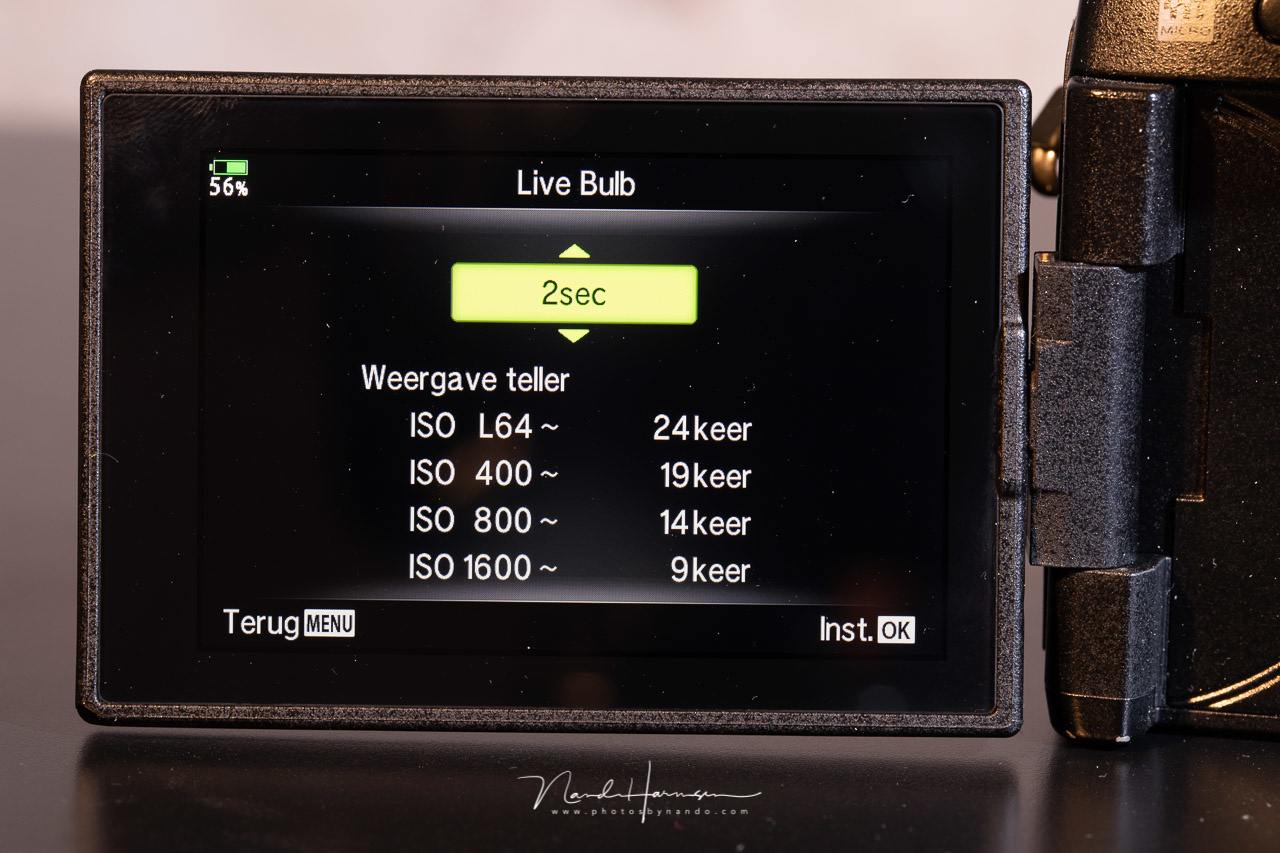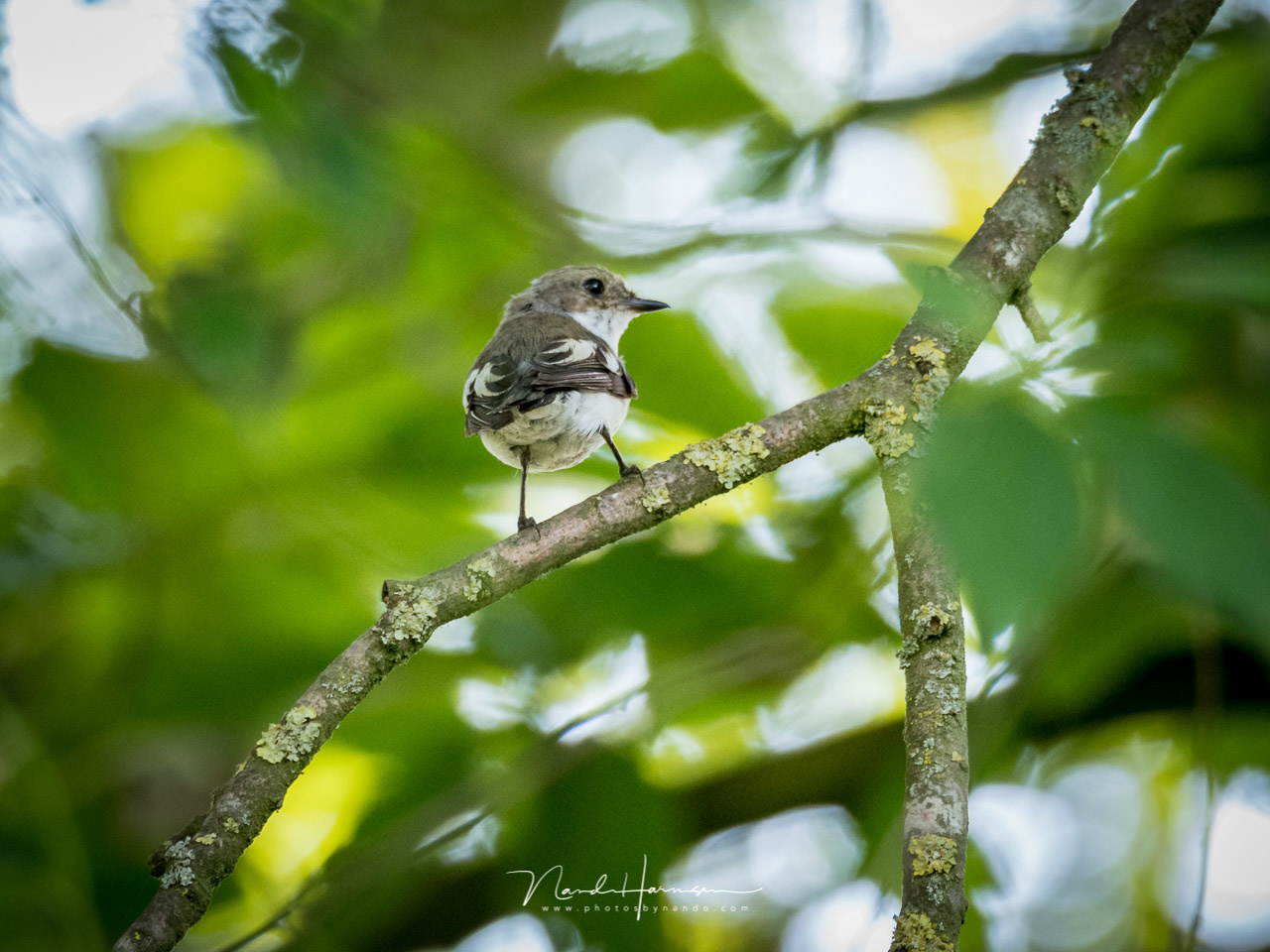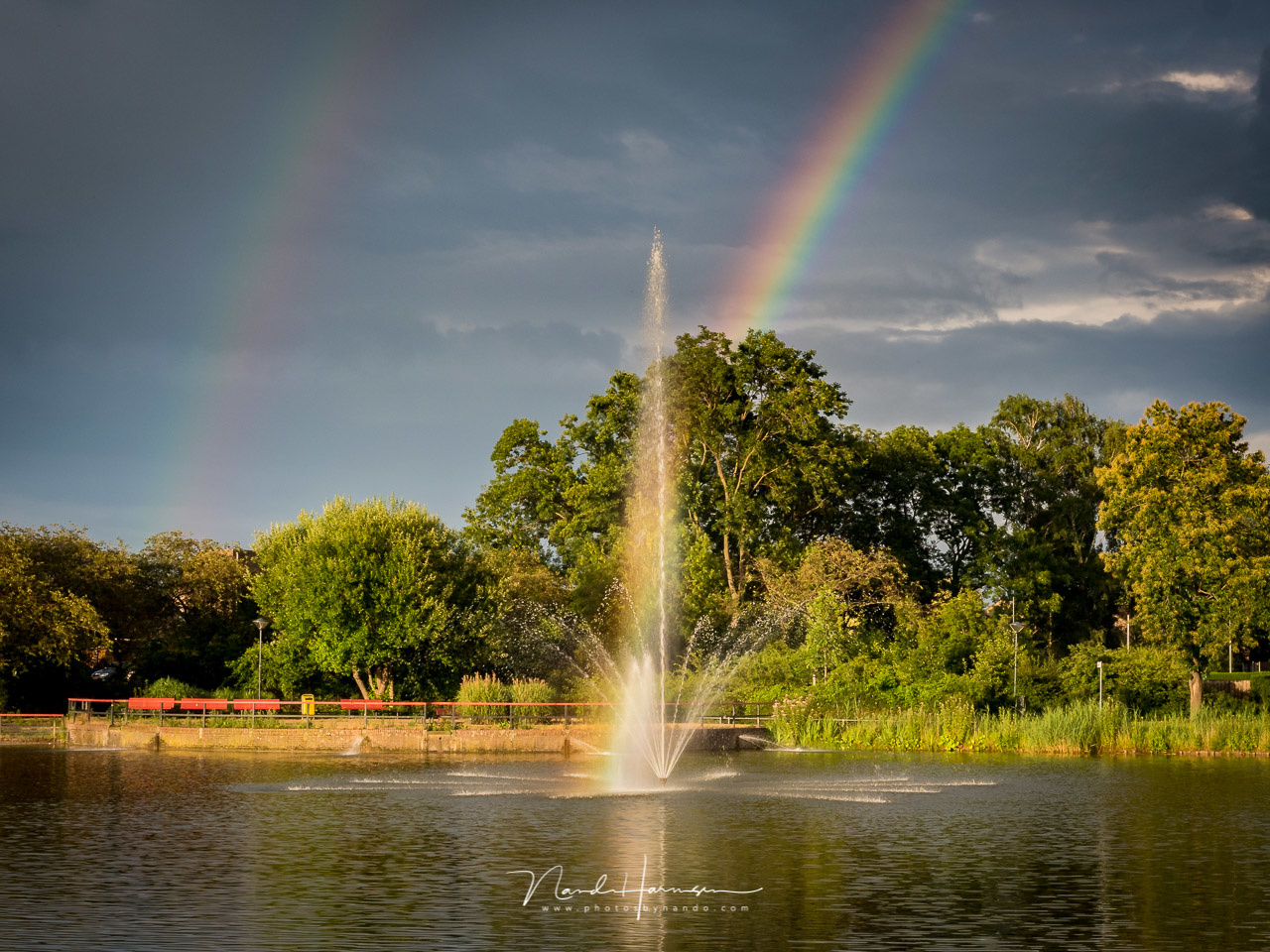I have met a lot of photographers who are using an Olympus camera. They are often very enthusiastic about their gear. A lot of their functions cannot be found in other cameras, which makes Olympus quite unique. If these cameras are so unique, why aren’t these more popular? I tried an Olympus for a few weeks to find out.
The Olympus OM-D cameras are compact and lightweight. A camera with a set of lenses can be carried in a small camera bag, perfect for traveling. When I guided a tour at Lofoten, the Olympus photographers in my group were the ones that traveled with only a small camera bag, while carrying more lenses than the Nikon, Canon, Fujfiilm, and Sony users.

The Olympus OM-D E-M1 II compared to the Canon EOS 5D Mark IV.
The thing that struck me the most were the amazing options that were built into these small cameras: live star tracking, seeing a long exposure gathering light live on screen, image stabilization that rendered a tripod unnecessary, and more. Often, I understood why the Olympus photographers were so enthusiastic about their cameras.
But at the same time, I wondered why Olympus cameras aren't more common. When I talked to the local camera shop, they said Olympus isn't selling very well. A lot of secondhand Olympus cameras were available. So, why is a Olympus camera not that popular, while it seems to be so great? To find out, I borrowed a Olympus OM-D E-M1 II with a nice set of lenses.
I wanted to try an Olympus for two reasons. First of all, I wanted to learn more about this small camera. Making myself familiar with it would make it possible to assist the workshop and masterclass participants that were using Olympus much better. But it would also give an idea of the capabilities of the camera itself.
One Camera and Four Lenses
I received the Olympus OM-D E-M1 II together with a M.Zuiko 17mm f/1.2 lens, a M.Zuiko 25mm f/1.2 lens, a M.Zuiko 12-40mm f/2.8 lens, and a M.Zuiko 75-300mm f/4.8-6.7. It is a wonderful set for both portrait photography and landscape photography. The lenses are great quality, although the 75-300mm lens is a cheaper, lesser model. Unfortunately, the current crisis made it not possible to arrange more than a single portrait session, for which the 17mm and 25mm lens were perfect.
The camera itself has a great design. Although it is very small, it feels very comfortable in my hands. The button layout is also very good. I don’t know if other Olympus camera models have the same feel, but I hope they do. There are two SD card slots available, something I find important. The one thing I did not particularly like was the rotation wheel around the shutter button, but it is something I could get used to. Although the PSAM wheel has the three custom settings, the Olympus also has a special handle to switch between two different states. It allows the user to customize the camera even more.
I haven’t been able to adjust the camera completely to my own needs. There wasn’t enough time for that. But it became clear how the settings of this camera can easily be changed completely with just a single switch. If you like to perform different kinds of photography like I do, it is very easy to change the camera into a completely different one.
Browsing Through the Menu
The menu structure of the Olympus OM-D E-M1 II is very extensive. It has six main categories, covering most standard settings. But it is the custom menu that offers an enormous amount of pages, each having up to seven settings. The pages range from the letter A to J, some of which are divided in different numbers, like A1, A2, A3, A4, and so on. In total, there are 21 different pages, making it time consuming to find a certain setting. There is some logical order, but it will take some time to learn to find the right setting very quickly. In particular, the more exotic options are located far away, and it might take more time to reach a certain setting. Some options are somewhat cryptic, requiring the manual to find out what they do.

The menu is quite extensive. If you don't know where to find a setting, it can take some time to find it.

One of the amazing capabilities of this camera: the live bulb. See your image gathering light live on screen.
Unfortunately, Olympus does not provide a personal menu option, which would allow you to gather a selection of menu options that will be used very regularly. Although a lot of buttons can be customized, a custom menu option would be more than welcome.
It Is So Small Because It Has a Smaller Sensor
Using the Olympus OM-D E-M1 II is a lot of fun. But taking it with you is even more fun. Compared to my Canon EOS 5D Mark IV, it feels almost like a small compact camera, while offering more options than the Canon. The size and weight of the Olympus system makes it very convenient for travel or to take the camera with you on a long hike.
The M43 sensor of the Olympus is the reason for its reduced size and weight, of course. The sensor is about half the size of a full frame, which makes it able to minimize the dimensions of the camera and lenses. On top of that, it is a mirrorless camera, which has to be taking into account also when comparing it to a Canon EOS 5D Mark IV. The crop factor of the M43 sensor is 2x, making it possible to reduce the focal length. That is why the 17mm and 25mm f/1.2 lenses are perfect portrait lenses, resembling a 35mm and a 50mm on a full frame. But instead of being large and heavy lenses, these are very compact. The 75-300mm lens is an equivalent of 150-600mm on full frame, while the size is similar to a 24-105mm lens.

The 25mm f/1.2 lens is perfect for portraits. The camera has eye-AF, and it works fine. (M.Zuiko 25mm, ISO 200, f/1.4, 1/2,500)
The sensor of the Olympus OM-D E-M1 II is about 20 megapixels, which is more than enough for most types of photography. It produces a great image and nice colors out of the box, although I change every photo to my liking in Lightroom. Because of the small sensor, noise is likely to occur more easily when the ISO levels are raised and when more extreme post-processing is performed also. I believe this is the biggest issue when it comes to Olympus cameras.
Noise Levels
How bad is the noise? Well, I was shooting small birds with the M.Zuiko 75-300mm f/4.8-6.7 lens, which needed a higher ISO level because of its small aperture at 300mm. I bumped up the ISO levels to 2,500 and 3,200 and found out it wasn’t too bad at all. Yes, it has some noise compared to my big DSLR camera, but it can be reduced very well in Lightroom. This way, you end up with an image that can be used for a lot of applications.
Also, the dynamic range of the Olympus OM-D E-M1 II is not all that bad. Underexposed areas can be recovered reasonably well. Noise will occur more easily, of course. But then again, with the right amount of noise reduction, the result is acceptable.

The European Pied Flycatcher. The autofocus had some difficulties focusing on the bird's head. (M.Zuiko 75-300mm at 300mm, ISO 2,000, f/6.7, 1/125)
An Olympus Camera or Not an Olympus Camera?
I do like the Olympus OM-D E-M1 II very much. Its possibilities are amazing, and it handles very well despite its small size. But its small sensor makes it more difficult to shoot with high ISO levels. Also, the dynamic range of the camera's sensor is less than I would like to have, although I did not test it very thoroughly. For my landscape photography, I wouldn't care too much about the dynamic range of the sensor. On most occasions, it is better to use gradient filters or just plain old HDR. It is a completely different story when it comes down to my wedding photography. For that, I wouldn’t be happy using this Olympus camera.

A misty sunrise. Just use filters or bracketing for the exposure and you don't have to worry that much about dynamic range. Nevertheless, this is a single shot without filters. (M.zuiko 25mm, ISO 200, f/8, 1/60)
Bottom line, the Olympus is not the right camera for me. But I envy the users of the Olympus system for its small size and how easy it is to carry a camera and set of lenses with you. It is a very capable camera, with amazing possibilities that could benefit a lot of photographers. It is strange it isn’t more popular. I wonder, is it just because of its small sensor? Or is there another reason?
What do you think about the Olympus camera system? Are you using one? Please share your opinion or experiences in the comments below.
If you're passionate about taking your photography to the next level but aren't sure where to dive in, check out the Well-Rounded Photographer tutorial where you can learn eight different genres of photography in one place. If you purchase it now, or any of our other tutorials, you can save a 15% by using "ARTICLE" at checkout.

















I don't need to try something out for myself to know whether it will meet my needs or not. I can just look at the specs and know from that how good it will be at meeting my needs. Every camera I have ever used has performed exactly how I thought it would, based on reading the specs before I made the purchase.
With all my respect, but you post unedited photos with auto WB, probably a JPEG shoot and you say that Olympus sensors are not good enough for you. It is just hilarious :))
I can recommend you to take a look at these guy's work and then tell my that the quality is not enough for a 40'' print: https://500px.com/p/sulasulacom/galleries/all
All the best and please don't speak of what you don't know.
Watch what tone you use when you speak to your betters.
I am waiting for a real replay of what I have posted last time.
I confess I added the Olympus E5Mkii to my 5DMkiv for laziness and nostalgic reasons! It's a lot easier for an overweight photographer with dodgy knees to carry up Scottish hills! And it looks just like my first true (photographic) love - an Olympus OM1n! It's great to carry about and use unobtrusively, and I've had great fun using the 8mm f1.8 fisheye. The articulated screen is a useful alternative to an angle-finder.
On the other hand, the quarter-size 16MP sensor on the Olympus does have noticeable limitations that mean that for serious landscape work I will be lugging the 5D and L lenses around for the foreseeable future. Horses for courses, I guess!
Olympus m43 câmeras are a gift to the landscape photographer. You don’t have to stop down as far as the FF crew have to do to get massive dof. Although I have never been to the Scottish hills (yet) I know what you mean, I have the same problem with Welsh hills and the Cwmbrian hills.
Why not selling more? I think lots of contributing factors. 1. people would like to have a best quality as possible no matter if that makes any practical differences are not. Certainly full frame sensor cameras have plus point but people may not realize practical differences when viewing photos. 2. pixel peeking, and noise level higher in MFT formats are facts but overly considered beyond practical impacts, especially if one consume such photos on a laptop, tablet or smartphone screens. 3. Bokeh - is wonderful and perhaps overly advertised. For example and portrait photos, it is very nice to have a big bokeh for sure, and tend to give a better separation of the subject from its background but other situations such as citiscape, landscape or micro photography, end-to-end sharpness and deeper depth of focus can be a plus. But it is often not very much talked about, 4. pixel peeking capability in digital photography while you cannot easily do so on printed photos. So one look at pixel levels, one may prefer APC or full frame sensor format. But liked mentioned in the point 2, consuming on a small format display may not make much differences. 5. Sellers of cameras tend to recommend APC over MFT. My one wish to Olympus as a casual photographer is make face and eye detection much faster than today.
Olympus really needs to introduce a top of the line eye AF - for both humans and animals.